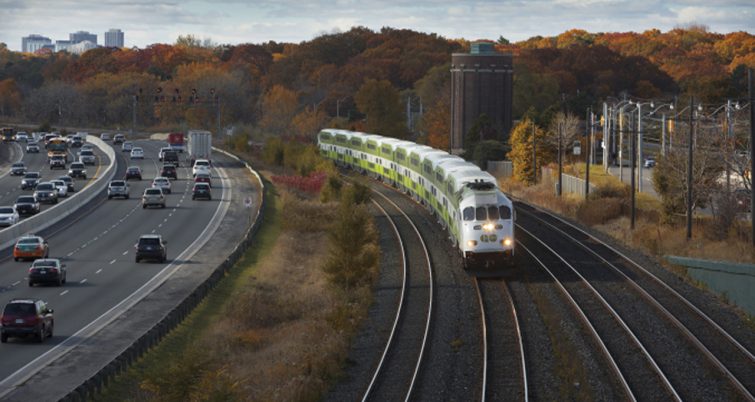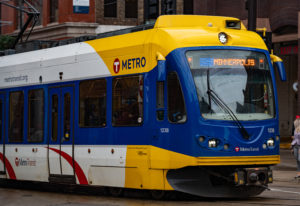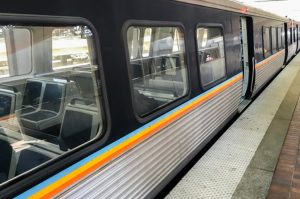Metrolinx work on Lakeshore East GO line moves into Small’s Creek
Written by Teresa Ko, Metrolinx
Construction along the Lakeshore East GO Transit line has been making progress and work is scheduled to begin in the Small’s Creek area in the coming weeks.
It’s part of the Lakeshore East rail corridor expansion project in Toronto, which supports GO Expansion for increased train service. Take a look at the work planned as well as what’s being done to minimize construction impacts and restore vegetation in the area.
Progress on expanding the Lakeshore East GO Transit rail line will move into Toronto’s Small’s Creek area, with an eye on working carefully around the important urban ravine and surrounding neighbourhoods.
Work has started on retaining walls that will be built between Jones Avenue and Coxwell Avenue as well as Woodbine Avenue to Warden Avenue. Retaining walls hold back the dirt securely allowing Metrolinx to expand the corridor – the large section of rail line – and install the fourth track in the future. These walls will also support the weight of passenger and freight trains. Crews will move into the Small’s Creek area in the coming weeks. This work is part of the Lakeshore East rail corridor expansion project in Toronto. The expansion project will enable the future addition of a fourth track and electrification on the Lakeshore East line. This means Metrolinx is making improvements today to bring communities along the GO line even more service in the future.


Crews will be accessing the rail corridor from the north and south sides. Once on site, those experts will begin removing certain trees and other vegetation along the south and north side of the rail corridor within Metrolinx’s property (Right-of-Way), adjacent to Wildwood Crescent.
Within Small’s Creek, Metrolinx has received approval from Toronto and Region Conservation Authority (TRCA) for construction. To make way for construction within regulated areas, vegetation removal is expected to begin in the coming weeks. This work is being conducted in preparation for the replacement of a collapsed culvert in Small’s Creek to restore the creek’s flow under the rail embankment.

Construction Access in the Merrill Bridge Dog Park
Temporary concrete barriers and fencing will be installed, and the access gate will be either locked or monitored to keep residents and pets safe from construction activities. Flagging staff will always be on site to direct trucks into the work sites, and drivers have been instructed to be extra cautious while driving through the residential neighbourhood.
Culvert Replacement
Preparing the area in advance will allow workers to access the existing culvert in Small’s Creek, which has failed and needs to be replaced. The new culvert will be adequately sized, will improve drainage, reduce potential flooding during storm events, as well as provide passage for small wildlife between the north and south side of the tracks. As previously shared with the community, Metrolinx remains committed to working with the City of Toronto and TRCA to restore the pathway on the north side of the rail corridor, which will be severed by the relocation of the culvert. Metrolinx will continue to engage the community and share additional information when available.
The new culvert installation is expected to begin in the summer and advance notice will be provided to residents.
You can see a fact sheet on retaining wall and culvert work in Small’s Creek here.
Retaining Walls
To add more frequent, electrified service, this segment of railway corridor needs to expand from three to four tracks, and specialized electrification infrastructure, like the portal structures that hold up the overhead catenary system (OCS), will be installed alongside them.
This new infrastructure will fit within the Metrolinx property line, however, the flat portion on the top of the current embankment is not wide enough to support the future fourth track. To address this, the corridor needs to be widened to the north side and grading work is required.
The retaining walls will be located at Egan Avenue, east of Jones Avenue, Small’s Creek to Bastedo Avenue, Kimridge Avenue, and Kennedy Road to Milne Avenue. A retaining wall allows the footprint of the work to be minimized, reducing the impact on surrounding properties, including the ravine and watercourse in Small’s Creek. This solution means that the slope and retaining walls will remain within Metrolinx property.
A T-Wall structure will be used in some sections of the Lakeshore East corridor between Pape Avenue and Kennedy Road. These walls are made of precast concrete and a chain link fence will then be located at the top of the wall for safety and security. Retaining walls will only be installed where needed to reduce the footprint of the slope and will not be continuous along the whole corridor.
Evening and overnight work
Working in an active corridor is a challenge and the works will take place during the day and night. Overnight schedules allow crews to work more efficiently and safely when trains are not operating because the construction is near the tracks.
“Metrolinx knows that night work is disruptive to residents,” said Emmanuel Essien, Metrolinx project manager. “To address this, Metrolinx requires our contractors to implement mitigation measures to minimize the disruption to the community.
“This includes no idling of non-essential equipment and will point lights away from residential windows as much as possible.”
Noise is an expected part of construction, but the goal will be to keep noise within reasonable levels through use of continuous noise and vibration monitoring equipment on construction sites. Frequent construction updates will also be provided to give residents the latest information on upcoming construction activities and what to expect.
Vegetation Removal
Metrolinx is removing trees not just for the current construction, but also for the upcoming electrification of the system. One of the key components of GO Expansion is for Metrolinx to electrify 600 kilometres of rail, to bring the region much faster and more frequent service. In preparation for electrification, crews are also removing trees and vegetation along the rail corridors, to protect the future wires, and keep passengers and neighbours safe.
For trees that are near the work zone, the workers are installing tree protection fences.
“We have worked diligently to reduce the number of trees to be removed for construction,” said Gretel Green, Metrolinx manager of environmental programs and assessment.
“Approximately 70 per cent of the trees being removed are invasive species. With input from the community, we have been working on a restoration plan with the City of Toronto and the Toronto and Region Conservation Authority and are committed to plant up to 2,000 native, locally sourced trees, shrubs and herbaceous plants in the ravine.”
Restoration plan will revitalize the biodiversity of Small’s Creek ravine
Invasive species greatly reduce biodiversity and outcompete the native vegetation reducing high quality habitat that wildlife depends on. The restoration plan will not just restore the area after construction but will also revitalize biodiversity by planting native species and restoring the native habitat for wildlife.
Metrolinx is committed to minimizing tree removals and after further review of construction plans, approximately 60 trees will be saved and no longer require removal.
The green space in the ravine serves as an important refuge for many residents, and the restoration plan will encourage the ravine to flourish for many years into the future.
During the project, different stages of construction, including the culvert work, will be staggered and advance notice will be provided to keep residents informed on what to expect.
“We have been working closely with the community and have met on several occasions to listen to concerns and answer questions,” said Adrian Martins, Metrolinx community relations and issues specialist.
“Metrolinx will continue to provide regular construction updates every step of the way and we encourage residents to sign up for the newsletter. Through public engagements and with local representation in our Construction Liaison Committee, we can work proactively to address community concerns and monitor construction impacts.”
For more information on this project, including access to all construction notices and newsletter registration, visit metrolinx.com/lakeshoreeastrailcorridor.
Follow project updates on Twitter @GOExpansion and reach out with questions anytime at [email protected].





